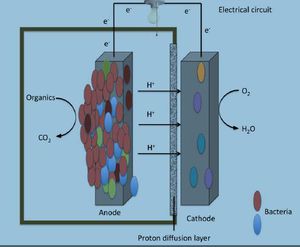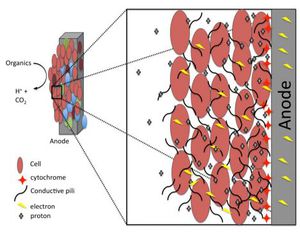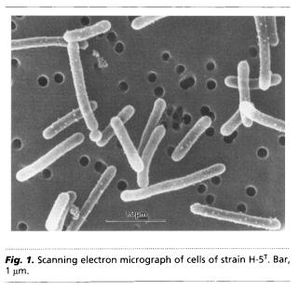User:Baileyk: Difference between revisions
| Line 25: | Line 25: | ||
==Section 2== | ==Section 2== | ||
<br>Include some current research, with at least one figure showing data.<br> | <br>Include some current research, with at least one figure showing data.<br>[[Image:geo3.jpg|thumb|300px|right|Figure 3. In current producing biofilms bacterial cells conduct electron transfer using membrane bound cytochromes. The bacterial cells use a long range network capable of conducting electron flow from the farthest cells to the closest ones to the anode. Oxidation of the organic substrate leads to a high concentration of protons under the biofilm mass where it is highest towards the anode (Franks and Nevin., 2010).]] | ||
==Section 3== | ==Section 3== | ||
Revision as of 23:30, 22 April 2013
Introduction
By [Kyle Bailey]
At right is a sample image insertion. It works for any image uploaded anywhere to MicrobeWiki. The insertion code consists of:
Double brackets: [[
Filename: PHIL_1181_lores.jpg
Thumbnail status: |thumb|
Pixel size: |300px|
Placement on page: |right|
Legend/credit: Electron micrograph of the Ebola Zaire virus. This was the first photo ever taken of the virus, on 10/13/1976. By Dr. F.A. Murphy, now at U.C. Davis, then at the CDC.
Closed double brackets: ]]
Other examples:
Bold
Italic
Subscript: H2O
Superscript: Fe3+
Introduce the topic of your paper. What microorganisms are of interest? Habitat? Applications for medicine and/or environment?
Section 1
Include some current research, with at least one figure showing data.

Section 2
Include some current research, with at least one figure showing data.

Section 3
Include some current research, with at least one figure showing data.
Conclusion
Overall text length at least 3,000 words, with at least 3 figures.
References
Edited by student of Joan Slonczewski for BIOL 238 Microbiology, 2011, Kenyon College.

